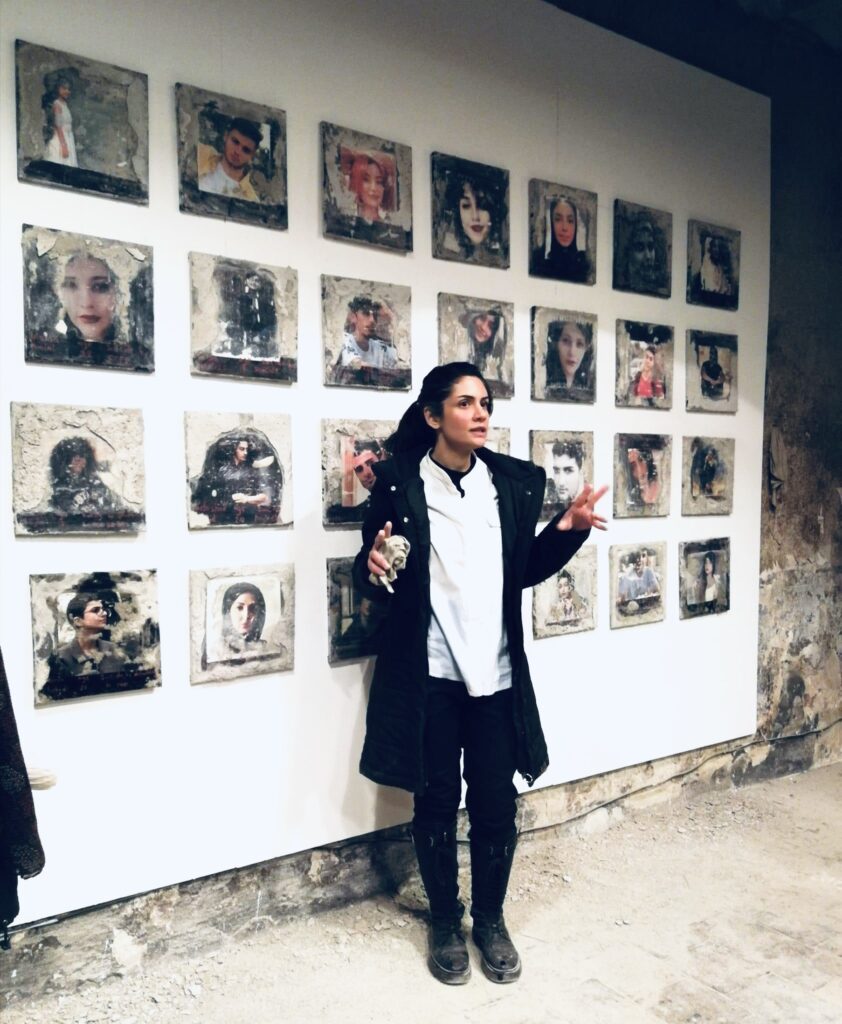EURO NEWS: Sadaf Ahmadi's 'Concrete' exhibition was praised when shown in France. Why won't it go on show fully in Borås?
Jonny Walfisz
Iranian artist Sadaf Ahmadi’s upcoming exhibition at Kulturhuset in Borås, Sweden has been censored by the gallery, the artist claims.
Ahmadi was born in Tehran, but moved to Borås where she has worked as a filmmaker and artist. Moved by the protests following the death of Mahsa Amini, a 22-year-old woman who was taken into Iranian police custody for not wearing a hijab according to government standards, Ahmadi created ‘Concrete’.
The innovative exhibition features portraits of people killed by the Iranian state. The portraits are covered in concrete, and Ahmadi asks visitors to break the concrete to reveal the hidden tales of Iran’s tragically lost people.
Alongside the portraits, ‘Concrete’ also features a walk-through exhibit of 10 veiled heads, hanging ghost-like from ropes. Alongside the portraits, the heads provoke a haunting sense of lives covered up and ultimately lost.
‘Concrete’ was first exhibited in March at La Maison des Chapitres in Forcalquier, France. Another exhibition followed at Paris’ Espace des Blancs Manteaux. Both were well received and went without incident.
The success of ‘Concrete’ led Ida Burén, the Head of Culture and Administration for Borås to bring the exhibition to the city’s culture centre Kulturhuset.
Due to start this month, Ahmadi was contacted earlier this week by the gallery’s curator claiming there would be security issues with staging the exhibition.
The concerns were regarding the hanging sculptures that were planned to be in the Kulturhuset’s entrance. The curator was concerned with the “work’s religious motif image which the viewer may be close to and/or associated with other religious actions such as the ongoing Koran burnings, and the increased risk image and increased security level that applies in Sweden,” they wrote to Ahmadi.
After contacting the city’s Cultural Administration, the gallery concluded that “ we would have had to raise the security level significantly in the Culture Center by bringing in guards during opening hours, having night patrols to avoid vandalism, etc.”
Ahmadi says the gallery was also concerned about reactions from Sweden’s far-right supporters.

“I was shocked. I was scared again,” Ahmadi tells Euronews Culture. “The same thing was happening to me that happened in Iran.” Even after she left Iran, she tells of how the experience of censorship in the country caused her to start “censoring myself.”
“Being censored is like raising a baby for nine months. And when you give birth to that baby, the baby is killed by a doctor. And there is nothing else you can do,” Ahmadi says.
When she moved to Sweden in 2020, she thought she was finally free to talk and create. ‘Concrete’ was the result of that. “Concrete is something that symbolically and in reality is covering everything in Islamic regime,” Ahmadi says.

The Kulturhuset offered to continue to show ‘Concrete’, but instead of putting the hanging veiled heads in the entrance, to move it to a small black-box theatre in the basement. Ahmadi was only offered this after “we made a stink about being censored,” explains her manager, Basil Glew-Galloway.
“It hurts because this installation is supposed to be open,” Ahmadi says, noting also the work already done with engineers to design the installation for the original exhibition space.
Ahmadi insists that her work, particularly the hanging veiled heads, are not meant as a criticism of Islam entirely, but of the Islamic Republic of Iran. “Everyone I know in Iran who believe they are Muslims, it doesn’t stop them from being themselves and desiring their freedoms.”
The civil unrest that followed Mahsa Amini’s death shows the side of Iran’s society that is against government censorship and the enforcement of laws such as those around the hijab. “I used the concrete to show the heaviness of the rules and all these obligations that I had to have, as a nine years old girl, and carry with me my whole life.”
Ahmadi points out a recurring phrase throughout the protests. “Freedom is an everyday practice.” While Ahmadi has encompassed that phrase into her art, the irony of censorship following her to Sweden is not lost on her.